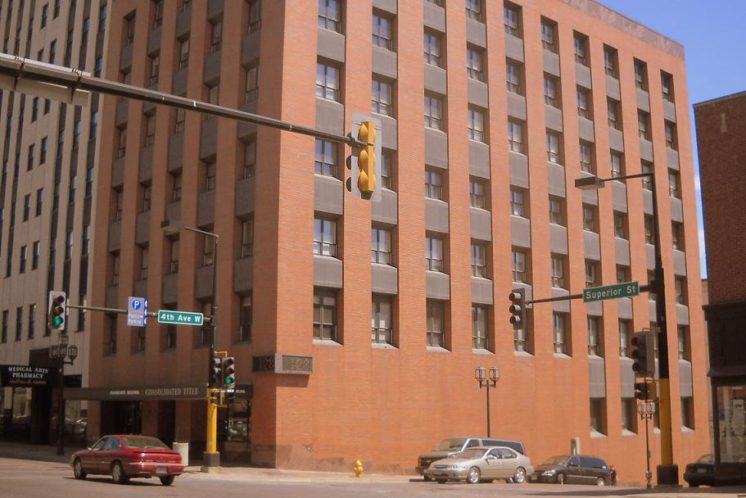The Providence Building opened in 1895 on the corner of Superior Street and Fourth Avenue West in Downtown Duluth. Originally it was a more ornate five-story building. A Northern Pacific Railroad office was located on the first floor.
Perfect Duluth Day’s fairy research spy found this Jan. 1, 1896 clip from the Duluth News Tribune about the Providence Building and its architects, John J. Wangenstein and William E. Baillie.
The top sketch shows what the Providence Building looked like back in the day. The caption reads:
Where the above architects have their offices is generally considered to be one of the best planned office buildings in Duluth, and this building, with a number of other business and tenement blocks and private residences planned by Wangenstein & Baillie during their long professional career in Duluth bear evidence to their skill as architects.
Two additional stories were added to the Providence Building in 1912. Below is a photo from the 1960s, courtesy of the Northeast Minnesota Historical Center.
The building was was substantially remodeled 1982, when its oval-shaped windows were removed. The building had a central fire vault made of clay, with steel doors that reached to the top floor, which was also removed in ’82.
What confused me about the newspaper clipping is the illustration of another building, with no description except for a fuzzy, unreadable caption.
It didn’t look like anything Duluth-related to me, so I asked Tony Dierckins’ of X-Communication about it. Then he asked Maryanne Norton at the Duluth Public Library and finally an answer was found. It’s the Itasca County Courthouse in Grand Rapids, built in 1894 and demolished in 1954.
So, there you have it. History mystery solved. Thanks Maryanne!
Wangenstein & Baillie were partners from 1892 to 1895. Their only other collaboration in Duluth I’m aware of is the Charles & Mary Britts Residence, which is featured in the Duluth Preservation Alliance’s booklet Historic Duluth’s East End Walking Tour. (Clip below.)
Wangenstein was born in Valders, Norway in 1858 and studied in Trondheim before coming to Duluth in 1883. He remained in Duluth until his death on July 23, 1942. His home was at 121 W. Saint Marie St.
Wangenstein’s résumé includes:
Lenox Hotel
1-15 N. Sixth Ave. W. (Demolished; replaced with Lenox Place Apartments)
Duluth Dry Goods & Provisions Co. (1893)
19th Ave. W. & Superior St.
Louis S. Loeb House (1900)
1123 E. Superior St. (recently demolished to make way for a Walgreens)
Wolvin Building (1901)
225-31 W. First St. (renamed the Missabe Building)
Gray Brothers Bakery (1904)
118-120 E. First St.
Duluth Masonic Temple (1904)
4 W. Second St.
Rowley Building (1905)
112 W. First St.
Duluth Board of Trade Building (1905, with Daniel Burnham)
301 W. First St.
Bridgeman Russell Building (1907)
10-16 W. First St.
St. Louis County Courthouse (1909, with Daniel Burnham)
100 N. Fifth Ave. W.
Wright-Clarkson Mercantile Co. (1910)
322-324 and 332 Michigan St.
DeWitt-Seitz Building (1911)
394 S. Lake Ave.
East End Ice and Coal Building (1916)
31 W. First St.
Altman Clothing (1922)
201-207 W. First St.
Gilbert Building (1922)
209-211 W. First St.
Commercial building (1923)
115 Second Ave. W.
Motor Mart (1923)
210 E. First St.
